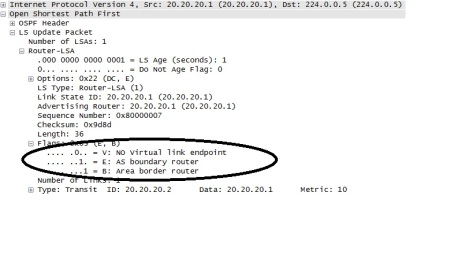As we continue our series on Summary ASB LSA 4 we look at LSA4 in NSSA(Not-s0-Stubby-Area).
we all know that the stubby area allows only Router LSA( type1 LSA), network LSA(type2 LSA) and the Summary LSA ( type3 LSA) , the only difference in NSSA is, it allows and generates type 7 LSA.
We saw why we need LSA4 , who generates and why it generated etc ..in the last post, this post involves what happens when we have NSSA AREA.
Here is our scenario.

Here are the configurations . I configure OSPF in the interfaces.
router ospf 1
area 1 nssa
IOU1#show run int et
IOU1#show run int ethernet 0/0
Building configuration…
Current configuration : 84 bytes
interface Ethernet0/0
ip address 10.10.10.1 255.255.255.0
ip ospf 1 area 1
end
IOU2#show run | s ospf
ip ospf 1 area 1
ip ospf 1 area 0
router ospf 1
area 1 nssa
IOU2#show run int et 0/0
Building configuration…
Current configuration : 84 bytes
interface Ethernet0/0
ip address 10.10.10.2 255.255.255.0
ip ospf 1 area 1
end
IOU2#show run int et 0/1
Building configuration…
Current configuration : 84 bytes
interface Ethernet0/1
ip address 20.20.20.1 255.255.255.0
ip ospf 1 area 0
end
IOU3#Show run | s ospf
ip ospf 1 area 0
router ospf 1
IOU3#show run int et 0/1
Building configuration…
Current configuration : 84 bytes
!
interface Ethernet0/1
ip address 20.20.20.2 255.255.255.0
ip ospf 1 area 0
end
As we can see there is nothing redistributed or injected in IOU1 so it doesnt generate LSA7.
IOU1#show ip ospf database | b External
IOU1#
As per the configuration,diagram IOU2 is the NSSA ABR So can we expect the IOU2 to be ASBR for the rest of the network?
Yes its the ASBR for the rest of the network since the NSSA ABR always translates the type 7 to type 5 unless the P-bit is cleared or unless the other NSSA ABR in multiple ABR scenarios, translates type 7 to type 5 in virtue of highest IP address.
we will come to know whats about the P – bit a bit later in the NSSA FA series .
There is no LSA type 7 from IOU1 as we saw above!!! will IOU2 still be the ASBR for the rest of the network?
Absolutely , Though there is no type 7 LSA from IOU1 , since its NSSA , the NSSA ABR IOU2 takes the role of the ASBR and sets the E bit to its neighbors indicating thats the ASBR.
- Here is the packet snippet from IOU2 to IOU3. we can see that IOU2 sets the E bit in router LSA as well as the B-bit indicating that its the ABR too.

we did see in the previous posts that with in the same area if we have ASBR we don’t need the type4 LSA because it reaches through the router LSA so IOU3 doesnt need one .
“what happens now when we connect another router to IOU3 in some other area will that router see an type 4 LSA ” ?
Lets do that and see what happens ..

Modified configuration of IOU3 since we added IOU4 .
IOU3#show run int et 0/0
Building configuration…
Current configuration : 84 bytes
!interface Ethernet0/0
ip address 30.30.30.1 255.255.255.0
ip ospf 1 area 2
end
IOU3#
IOU4#show run | s ospf
ip ospf 1 area 2
router ospf 1
IOU4#show run int et 0/0
Building configuration…
Current configuration : 84 bytes
interface Ethernet0/0
ip address 30.30.30.2 255.255.255.0
ip ospf 1 area 2
end
“After the neighborship is up , we can see type 4 LSA generated by IOU3 with the link ID as IOU2 since IOU is the ASBR ( converts type 7 to type5).”
IOU4#show ip ospf database | b Summary ASB
Summary ASB Link States (Area 2)
Link ID ADV Router Age Seq# Checksum
20.20.20.1 20.20.20.2 443 0x80000001 0x0015A1
IOU4#
Conclusion:
- Though we don’t redistribute anything or we dont see any external network injected or generated in NSSA , the NSSA ABR will take the role as the ASBR for the rest of the network and the ABR will generate the type4 LSA for the other networks.
Next in series will be the impact of FA in NSSA , Does FA modify external path selection ?what happens if we suppress FA ? etc..how does the ABR choose the best path to the external network in NSSA?
Tune in ..:)
Thanks and regards,
Avinash R

